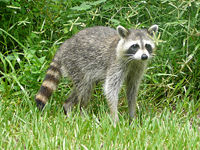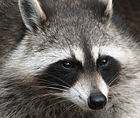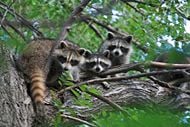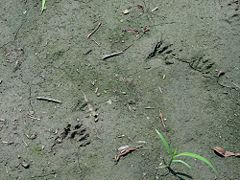Difference between revisions of "Raccoon" - New World Encyclopedia
Rick Swarts (talk | contribs) |
Rick Swarts (talk | contribs) (readded CONTRACTED tag which had been inadvertedly placed under "common raccoon") |
||
| Line 1: | Line 1: | ||
| − | {{Claimed}} | + | {{Claimed}}{{Contracted}} |
{{Taxobox | {{Taxobox | ||
| color = pink | | color = pink | ||
Revision as of 03:44, 30 November 2007
| Raccoon | ||||||||||||
|---|---|---|---|---|---|---|---|---|---|---|---|---|
 | ||||||||||||
| Scientific classification | ||||||||||||
| ||||||||||||
| Procyon lotor Linnaeus, 1758 | ||||||||||||
|
Procyon cancrivorus |
A raccoon (or racoon) is any one of three species of nocturnal mammals which constitute the genus Procyon of the Procyonidae family. The most widespread species, the Common Raccoon (P. lotor), is often known simply as the raccoon, as the two other raccoon species in the genus are native only to the tropics and are considerably lesser-known.
General attributes
Raccoons are unusual, for their thumbs (though not opposable) enable them to open many closed containers (such as garbage cans and doors). They are omnivores with a reputation for being clever and mischievous; their intelligence and dexterity equip them to survive in a wide range of environments and are one of the few medium-to-large-sized animals that have enlarged its range since human encroachment began (another is the coyote). Raccoon hindfeet are plantigrade similar to a human's. Raccoons are often considered a nuisance, and are common in campgrounds of North America, especially in the Midwest. Many people are surprised when a creature that they usually think of as cute or cuddly raids their campsite at night and makes odd growls and fights viciously over scraps of food left out by campers.
Although there is some variation depending on the species in question, raccoons range from 20-40 inches in length (including the tail) and weigh between 10 and 35 lbs. The raccoon's tail ranges from 8 to 16 inches in length. Male raccoons are generally larger than females. A baby raccoon is called a kit[1].
Species
There are three species of raccoon. The most widespread is the Common Raccoon, also known as the Northern Raccoon, which has a natural range of Southern Canada to Southern Mexico and has been introduced to Continental Europe. Raccoons can live in the city or in the wild, and while they are not domesticated they are on rare occasion kept as pets.
The two rarer species are the Tres Marias Raccoon (P. insularis), native to the Tres Marías islands off the Pacific Coast of Mexico, and the Crab-eating Raccoon (P. cancrivorus) of tropical Central and South America.
Some raccoons once considered separate species are now thought to be the same as or subspecies of the common raccoon, including the Barbados Raccoon (P. gloveralleni), Nassau Raccoon (P. maynardi), Guadeloupe Raccoon (P. minor), and Cozumel Island Raccoon (P. pygmaeus) (Helgen and Wilson 2005).
Nomenclature
The word "raccoon" is derived from the Algonquian word aroughcoune, "he who scratches with his hands." Spanish-speaking colonists similarly adopted their term, mapache, from the Nahuatl word for the animal, meaning roughly "that which has hands."
The genus name, Procyon, comes from the Greek for "pre-dog"; this term is also used for the star Procyon of the constellation Canis Minor.
Raccoons are today understood to have a relatively loose evolutionary relationship with bears which was nonetheless seen as significant by the early taxonomists; Carolus Linnaeus initially placed the Raccoon in the genus Ursus. In many languages, the raccoon is named for its characteristic dousing behavior in conjunction with that language's term for "bear": Waschbär in German, mosómedve in Hungarian, vaskebjørn in Danish and Norwegian, tvättbjörn in Swedish, wasbeer in Dutch, pesukarhu in Finnish, araiguma (洗熊) in Japanese, orsetto lavatore in Italian, huànxióng (浣熊) in Chinese and миеща мечка in Bulgarian all mean "washing bear."
In some cases, the "washing" descriptor is applied only to the Common Raccoon species: for example, in French the common raccoon is called raton laveur or "washing rat," while its Linnaean binomial is Procyon lotor or, roughly, "washing pre-dog." In contrast, the Crab-eating Raccoon is "little crab-catching rat" (raton crabier) and "crab-eating pre-dog" (Procyon cancrivorous) in French and Latin, respectively.
Common racoon
| Common Raccoon (or Racoon) | ||||||||||||||
|---|---|---|---|---|---|---|---|---|---|---|---|---|---|---|
| File:Raccoon (Procyon lotor) 1.jpg | ||||||||||||||
| Scientific classification | ||||||||||||||
| ||||||||||||||
| Procyon lotor (Linnaeus, 1758) | ||||||||||||||
| Common Raccoon native range in red, feral range in blue. Common Raccoon native range in red, feral range in blue.
| ||||||||||||||
|
Ursus lotor Linnaeus, 1758 |
The Common Raccoon (Procyon lotor), also known as the Northern Raccoon, Raccoon, or Coon, is a widespread, medium-sized, omnivorous mammal native to North America.
Since the 20th century, raccoons have also become widespread on the European mainland and in the Caucasus region, after having escaping from fur farms[2][3]. Raccoons usually live together in small, loose groups. Their original habitats are mixed or deciduous forests, but due to their adaptability, they are often found in urban areas where they can be considered pests at times.
At one time, raccoons were aggressively trapped for their fur. Populations suffered greatly but have recovered. In popular culture, American frontiersmen such as Daniel Boone and Davy Crockett were often portrayed wearing coonskin caps. Historians believe, however, that it is unlikely that either of them actually wore such caps.
Appearance
Adult weights vary with habitat and range and can range from 3 to 16 kg (6.6 to 35 pounds) and measure 60 to 90 cm (24 to 36 in) along the body, minus the 25 cm/10 in tail. The smallest races of those found in Southern Florida, while those near the Northern limits of the raccoon's range tend to be the largest. The largest recorded raccoon was over 28 kg (61 pounds), by far the largest size recorded for a family member of the Procyonidae[4]. They have black facial colorings around the eyes, and have a bushy tail with light and dark alternating rings. The coat is a mixture of gray, brown, and black fur. On rare occasions, raccoons may be albino. Currently there is a search under way to validate sightings of half albino raccoons. These sightings have occurred in Indiana, specifically the West Lafayette region. The dark patches around the eyes, perhaps the raccoon's most prominent trait, are reminiscent of a "bandit's mask," which has enhanced its reputation for mischief, vandalism, and thievery.
Raccoons have 40 teeth, which are adapted to an omnivorous lifestyle. The chewing surface is not as wide as for herbivores, but the teeth are not as sharp and pointed as those of a carnivore.
Behavior
Raccoons are omnivorous, consuming a varied diet that includes berries, insects, eggs and small animals. Raccoons sometimes wash, or douse, their food in water before eating it. It is not known why raccoons perform dousing, but cleaning food is unlikely to be the reason. Studies have found that raccoons engage in dousing motions when water is unavailable; researchers note that captive raccoons are more likely than wild raccoons to douse food. It has been suggested that captive raccoons are mimicking fishing and shellfish-foraging behaviors. It may also be that the raccoon is searching for unwanted material, as water is thought to heighten their sense of touch.
As city dwellers in the United States and Canada increasingly move into primary or second homes in former rural areas, raccoons are often considered pests because they forage in trash receptacles or eat dog food left on back porches. They are able to open garbage cans with their thumbs (which are not opposable). Raccoons also pose a serious risk to any household pet within their vicinity; it is not uncommon for raccoons to seriously injure, kill or eat cats and small dogs.
Introduced into Germany in the 19th century, raccoons seeking food in wine cellars and storage areas have become a threat to the country's wine industry. Beginning in April 1934 raccoons, which were being commercially farmed in Germany for their then-fashionable fur, were experimentally released into the wild[5] in the Kellerwald range. Population growth greatly accelerated in 1945 when disruption of the infrastructure led to numerous raccoons escaping from farms across Germany. Because they appeared to have minimal impact on forest ecology, raccoons were initially a protected species. This status has changed in recent years, however, as the species' population density in some regions may have reached 100 raccoons per square kilometer. In certain areas, hunters have been offered rewards to cull the animals[6].
The aggressive nature of raccoons is innate, and the behavior begins to appear within 4-6 weeks after birth[7].
Mating
Mating usually occurs in January or February, and a litter of four or five young are born in April or May (varies by climate). Raccoons usually live in hollow trees, ground burrows, or caves. They often travel along streams or rivers in search of food. However, there are raccoons that live in the forest not near any stream. Males have no part in raising the young. By late summer, the litter will be weaned and will begin to fend for themselves. In severe winter climates, raccoons may become dormant but do not hibernate. Not all sleep in the morning.
Range
Raccoons are common throughout North America from southern Canada to Panama. Raccoons are one of the largest animals to have adapted well to human development. Suburban areas, and many large cities, have significant raccoon populations. Raccoons are skilled foragers who can thrive on garbage and pet food. They have been known to take up residence in attics and garages, and even to enter houses through "pet doors" in search of food. When confronted by humans or household animals, raccoons may be aggressive, but urban raccoons tend to lose their fear of humans over time, which generally manifests as an attitude of "if you don't bother me, I won't bother you." A good example of this can be seen if a glass windowpane ever separates human and city-dwelling raccoon. As often as not, the raccoon's response will be indifference or even curiosity, even while under direct observation.
In 1934, Hermann Goering, then head of the Reich Forestry Office, gave permission for the release of a pair of raccoons into the German wilderness to enrich the fauna. [8] [9] The raccoons have since been extremely successful due to the lack of natural enemies. Others are believed to have escaped from fur farms during Allied bombing in World War II.[citation needed] The German newsmagazine Der Spiegel reported in 2002 that the raccoon had established itself in a small area of north-central France and in a considerable area of central Germany, where it had become a neighborhood pest to some and a beloved pet to others.
While raccoons held in captivity can live up to 20 years, they seldom live longer than 12 years in the wild, with most only living a few years. The species' life expectancy in the wild is only about 1.3 to 3.1 years, and only about half of all males survive their first year. Illnesses, accidents, and the death of the mother are the most common causes of death for young raccoons. For adult raccoons, traffic incidents and hunting account for more than 75% of deaths. In the 1980s in the United States, nearly five million raccoons were shot every year.[citation needed]
Disease
Raccoons can carry Baylisascaris roundworm, canine distemper, parvovirus and rabies[10]. Of the 6,844 documented rabies cases reported in the United States in 2004, 37.5% were in raccoons (Krebs et al. 2005, pp. 1912-1925). Seeing a raccoon during the day is an indicator, though not absolute, that the animal may be ill. However, healthy animals, especially nursing mothers, may also forage for food in the daytime. Rabies may be entirely without visible symptoms in the raccoon.
Raccoon rabies is as dangerous to humans as any other strain, even though there is only one documented case in which it has led to a fatal case of human rabies [11]. Any animal with suspected rabies should not be approached. If it requires killing, the local health department should be notified to obtain instructions on means of disposal. Saliva, and other bodily fluids may carry the rabies virus. Many communities have animal control officers who can deal with rabid animals.
Rabies is so prevalent in some populations of wild raccoons that several states and the U.S. federal government, as well as authorities in Canada, have developed programs of oral vaccination to try to reduce the spread of this lethal disease[12][13][14].
Raccoons as food
Raccoons were a source of food for early American pioneers, providing a sizeable amount of protein. Nowadays, people generally do not consider raccoon desirable. It is, however, a good tasting meat to some hunters, and is still eaten and prepared in certain regions of the American South.
An older edition of The Joy of Cooking has a recipe for preparing raccoon, along with squirrel, opossum, and other game animals. It is suggested that removing the musk glands and the fat before roasting (a favored cooking method) will help tone down the strong game flavor. It is also suggested that sweet potatoes are complimentary with the raccoon’s meat (which is dark) as either a stuffing or side dish.
The limited interest in eating raccoon is most likely attributed to the emotive association people have with the animal; being intelligent and adaptable. Its reputation as a scavenger is also a common factor with people (see Taboo food and drink).
Raccoons as pets
In most states of the United States it is illegal to keep raccoons as pets (see rabies). Some states allow the practice, but require exotic pet permits[15]. Wild, young orphan raccoons may carry rabies. Tamed raccoons acquired from reputable breeders may make suitable pets; however, raccoons are not technically domesticated animals. Training raccoons is an intensive and ongoing process. Many captive raccoons may retain destructive or aggressive natural behaviors, such as biting. Some douse their food in or defecate into the water dishes of other pets. Although nocturnal, captive raccoons can be trained to sleep at night and to be active during the day.
Captive raccoons can develop obesity and other disorders due to unnatural diet and lack of exercise; furthermore, many veterinarians may not treat raccoons. Raccoons raised in captivity and released do not adapt well to life outside.[citation needed]
ReferencesISBN links support NWE through referral fees
- ↑ Raccoon facts
- ↑ http://www.dw-world.de/dw/article/0,1564,1390574,00.html
- ↑ http://www.wildlifebiology.com/1996/1996kauhala.html
- ↑ http://www.nature.ca/notebooks/english/racoon.htm
- ↑ Raccoons in Germany
- ↑ Nazi racoons invade the wineland
- ↑ [*Crazy Beagle: Sleepy Coon]
- ↑ http://www.dw-world.de/dw/article/0,,1390574,00.html
- ↑ http://www.timesonline.co.uk/article/0,,13509-1846678,00.html
- ↑ Rabies - Natural History
- ↑ First Human Death Associated with Raccoon Rabies - Virginia 2003
- ↑ Cornell-Quebec project aims to turn back raccoon rabies from international border
- ↑ Preventing Spread of Raccoon Rabies West of North Carolina: Oral Rabies Vaccine Program
- ↑ Raccoons and Rabies
- ↑ State Regulations Concerning the Possession of Raccoons as Pets
- Krebs, J.W., Mandel, E.J. & Swedlow, D.L., et al. (2005), "Rabies surveillance in the United States during 2004", J Am Vet Med Assoc, vol. 227, no. 12, pp. 1912-1925.
- Davidson, Alan (1999). "Raccoon", Oxford Companion to Food, 648. ISBN 0-19-211579-0.
- Helgen, K.M. and Wilson, D.E. (2003). Taxonomic status and conservation relevance of the raccoons (Procyon spp.) of the West Indies. Journal of Zoology 259: 69-76.
- Helgen, K.M. & Wilson, D.E. 2005. A systematic and zoogeographic overview of the raccoons of Mexico and Central America. Pp. 219-234 in Sanchez-Cordero, V. & Medellin, R.A. (eds.). Contribuciones Mastozoologicas: en Homenaje a Bernardo Villa. Mexico City: Instituto de Biologia e Instituto de Ecologia, UNAM.
External links
- Raccoon Tracks information, accounts, and images
- range of raccoon populations, Missouri Botanical Garden
- Feature Creatures: Raccoon University of Alberta Museum of Zoology
- Remo Raccoon's Home Page
- Nazi Raccoons On The March In Europe article about history of raccoon introduction in Germany
- Crazy Beagle: Sleepy Coon young aggressive male
- Raccoon entry on Encyclopedia.com
- Raccoons on Bear Tracker
- Raccoons on an elementary school website
- World Wide Raccoon Web Gallery
- Raccoon pictures
Credits
New World Encyclopedia writers and editors rewrote and completed the Wikipedia article in accordance with New World Encyclopedia standards. This article abides by terms of the Creative Commons CC-by-sa 3.0 License (CC-by-sa), which may be used and disseminated with proper attribution. Credit is due under the terms of this license that can reference both the New World Encyclopedia contributors and the selfless volunteer contributors of the Wikimedia Foundation. To cite this article click here for a list of acceptable citing formats.The history of earlier contributions by wikipedians is accessible to researchers here:
The history of this article since it was imported to New World Encyclopedia:
Note: Some restrictions may apply to use of individual images which are separately licensed.






